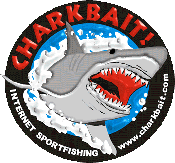|
|
Fishermen's Journal |
White Seabass
by
Capt.
Jerry Barber
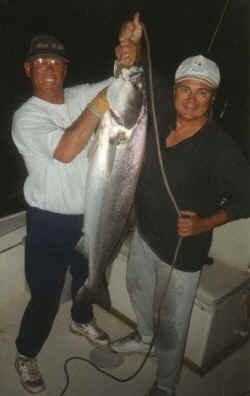 In
the Springtime, a man’s mind turns to…SEABASS!
At least mine does. To me,
there is no finer eating fish in the world.
The big croakers are making a tremendous comeback after years of
pollution and gill netting took their toll.
The efforts of a few, notably United Anglers and the Hubbs-Sea World
Research Institute, have really made a difference.
United Anglers assisted in getting legislation passed which now prohibits
gill nets within three miles of the coastline.
The Hubbs-Sea World Research Institute operates the white seabass
hatchery at Carlsbad. The
researchers and volunteers have raised, tagged and released approximately
413,000 juvenile seabass into the waters of Southern California since 1986.
In
the Springtime, a man’s mind turns to…SEABASS!
At least mine does. To me,
there is no finer eating fish in the world.
The big croakers are making a tremendous comeback after years of
pollution and gill netting took their toll.
The efforts of a few, notably United Anglers and the Hubbs-Sea World
Research Institute, have really made a difference.
United Anglers assisted in getting legislation passed which now prohibits
gill nets within three miles of the coastline.
The Hubbs-Sea World Research Institute operates the white seabass
hatchery at Carlsbad. The
researchers and volunteers have raised, tagged and released approximately
413,000 juvenile seabass into the waters of Southern California since 1986.
Most anglers start looking for seabass around March but the
most productive months are April, May and June. The best local spots are found around the Channel Islands
with Catalina and San Clemente Islands arguably being the top producers.
This is undoubtedly due to their proximity to the Long Beach and Los
Angeles sportfishing fleets. A lot
of fishermen work these waters and, as a result, catch a lot of fish.
The best spots are well known and documented on most
fishing charts. Most Catalina fish
come from the areas of
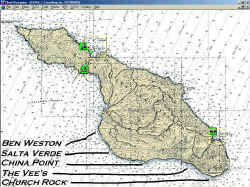 “The V’s”, Silver Canyon, the beaches of Ben
Weston, Shark Harbor, West Cove, Johnson Rock, Eagle Reef, Ship Rock and the
“High Spot” at the Isthmus. The
best of the best are probably “The V’s” and West Cove.
“The V’s”, named after the three canyons visible from seaward just
west of Church Rock, is the primary spawning area for squid at the island.
The squid attract and hold the seabass and the area is sometimes
wall-to-wall boats. The best water
to fish is the “dirty” or chalk-colored water close to the beaches.
Good spots at San Clemente Island include the kelp beds at China Point,
the boiler rocks near Pyramid Cove, and White Rock, Little Flower and Fishhook
on the inside near the radar dome.
“The V’s”, Silver Canyon, the beaches of Ben
Weston, Shark Harbor, West Cove, Johnson Rock, Eagle Reef, Ship Rock and the
“High Spot” at the Isthmus. The
best of the best are probably “The V’s” and West Cove.
“The V’s”, named after the three canyons visible from seaward just
west of Church Rock, is the primary spawning area for squid at the island.
The squid attract and hold the seabass and the area is sometimes
wall-to-wall boats. The best water
to fish is the “dirty” or chalk-colored water close to the beaches.
Good spots at San Clemente Island include the kelp beds at China Point,
the boiler rocks near Pyramid Cove, and White Rock, Little Flower and Fishhook
on the inside near the radar dome.
Most knowledgeable seabass anglers agree the best time of
the month to fish is the dark of the moon and again during the full moon. These
phases of the moon produce the highest tides and therefore the most water
movement, which is so necessary for good fishing. My personal preference is the dark of the moon, simply
because I feel the fish feed heavier at dawn and dusk, the two “best”
fishing times, when there is no moonlight all night long.
Another “best” fishing time is the four-hour period that falls two
hours before and after the high and low slack tides.
When these four-hour periods coincide with early dawn (4:00 to 7:00 AM)
or dusk (7:00 to 10:00 PM), it’s a bonanza!
As I mentioned earlier, the food of choice for a seabass is
squid. Live is best, followed by
fresh dead and then frozen. Other
than squid, seabass readily eat live “gulper” mackerel, Spanish mackerel,
sardines and palm-size Blacksmith, a very hearty member of the Damselfish
family. These can all be jigged up
using Lucky Joe’s. If you tip the
hooks with small pieces of squid, your catch ratios will increase markedly.
When I worked at the Isthmus, I used Blacksmiths almost exclusively.
Be sure and use the smaller ones though, no bigger than the palm of your
hand. The bigger ones are just too
strong. Another tip: If all you
have are larger greenback mackerel, just clip off the lobes of the tail.
This reduces the horsepower of the fish to a manageable level.
Seabass fishing is primarily a sit-and-wait type of
fishing. Any yellowtail or small
tuna outfit should work fine. For
years, I used a 270H for seabass but recently switched to a Seeker Graphite 665F
with a Penn 535 reel modified with the 4.25:1 gears.
You definitely don’t need a high-speed reel for seabass fishing.
They can really beat you up if you use a long rod or a high-speed reel.
Match the hook to the size of your bait but 90% of your fishing should be
done with a 3/0 Mustad 94150 (or similar) live bait hook or a 4/0 Mutu circle
hook. Twenty-five to thirty pound
test line is usually about right. My
personal line of choice is Original (thin) 25# P-Line.
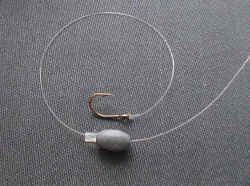 I
see a lot of other Captains recommending dropper loops to fish seabass.
I personally don’t like dropper loops because knots in the line
translate to weak points. I much
prefer a “slider rig” where the only knot in the line is at the hook.
To rig a slider, run a 1 to 3 oz. egg sinker up your line and stop it
using a Carolina Keeper (instead of a split-shot) about three to four feet up
from the hook. For those of you
unfamiliar with a Keeper, it is a small, round piece of plastic with a slit in
the center. You compress the slit
to open it by using needle-nose pliers. Feed
the mono through the hole, slide the Keeper up the line the desired distance and
release the pliers. The slit closes
and clamps onto the mono without damaging it like a spit-shot often does.
Once rigged, hook up a lively bait and drop it to the bottom.
Crank it up about six to ten turns off the bottom and you’re all ready. Be sure to keep the reel out of gear with the clicker on.
Most anglers prefer to just set the rod in a holder and wait.
Seabass will hit the bait in any number of ways.
Sometimes it’s just a subtle nibble, while other times they will hit
like a freight train. My first
seabass at Catalina many years ago, a 37 pounder, took over 50 yards of line off
the reel before I was able to get it in gear…and I was sitting right next to
it.
I
see a lot of other Captains recommending dropper loops to fish seabass.
I personally don’t like dropper loops because knots in the line
translate to weak points. I much
prefer a “slider rig” where the only knot in the line is at the hook.
To rig a slider, run a 1 to 3 oz. egg sinker up your line and stop it
using a Carolina Keeper (instead of a split-shot) about three to four feet up
from the hook. For those of you
unfamiliar with a Keeper, it is a small, round piece of plastic with a slit in
the center. You compress the slit
to open it by using needle-nose pliers. Feed
the mono through the hole, slide the Keeper up the line the desired distance and
release the pliers. The slit closes
and clamps onto the mono without damaging it like a spit-shot often does.
Once rigged, hook up a lively bait and drop it to the bottom.
Crank it up about six to ten turns off the bottom and you’re all ready. Be sure to keep the reel out of gear with the clicker on.
Most anglers prefer to just set the rod in a holder and wait.
Seabass will hit the bait in any number of ways.
Sometimes it’s just a subtle nibble, while other times they will hit
like a freight train. My first
seabass at Catalina many years ago, a 37 pounder, took over 50 yards of line off
the reel before I was able to get it in gear…and I was sitting right next to
it.
If you are anchored up on your favorite seabass hole and
there is a good current running, I suggest rigging up a second rod with a light
Iron Man “Seabass Special”, an all-white jig with a red “Z” smear at the
ring end. Pin two squid on the
hooks and let it down to about ten feet above the bottom.
Set the rod in a holder and let the rocking motion of the boat do the
rest. Use a rod equipped with a
lever drag reel if you have one. This
outfit should have a little more resistance to it than a clicker provides.
I like to set the lever with enough resistance to set the hooks but not
enough to pin the rod to the rail if the fish hits hard.
Too much resistance could snap a rod.
Use caution. Seabass usually
tend to fight hard for several minutes and then give up considerably and can be
reeled right in.
In my experience at Catalina, I have found the larger fish
to be at ”The V’s” and the Isthmus. There
are large fish as well at West Cove, but many smaller just-legal fish inhabit
that area due to the grow-out pens at Catalina Harbor.
Right in Cat Harbor itself are two pens used to raise the seabass from
the 4” hatchery fish to larger fish which are then released into the waters of
Cat Harbor. Studies have shown that
most released fish tend to stay in protected waters for about a year and then
move to outside waters. West Cove
is only a short distance west of Cat Harbor and has become a community for the
smaller hatchery fish. The tagged
fish are just now reaching legal size.
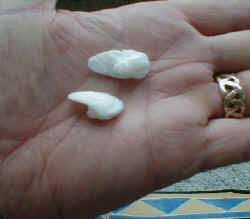 Seabass
are tagged by inserting a very small stainless steel wire in the cheek of the
fish. This wire is approximately
1/8” long and the diameter of a cat whisker.
It is found by using a very specialized hand-held metal detecting wand,
similar to those used at airports. Any
just-legal seabass should be considered as a tagged fish.
A few fish were marked externally as well, but that practice has been
discontinued. The Hubbs Hatchery is
requesting any angler catching a seabass to remove the head and send it to the
hatchery to be checked for a tag. Please
attach a tag to the head indicating when and where the fish was caught along
with its length and weight. The
information is invaluable for research. Several
freezers have been designated at various landings to receive the heads for later
transfer to the hatchery. A list of
all locations accepting seabass heads for tag checks will soon be posted on the
hatchery website at
www.hswri.org.
For those of you who remove the “stones” from the ear canals within
the heads of the fish, this will not affect the checking of the tags.
“Stones” are two small calcium growths found inside the heads of
seabass and are collected by some as trophies.
They can be made into jewelry as well as just being objects of curiosity
and conversation.
Seabass
are tagged by inserting a very small stainless steel wire in the cheek of the
fish. This wire is approximately
1/8” long and the diameter of a cat whisker.
It is found by using a very specialized hand-held metal detecting wand,
similar to those used at airports. Any
just-legal seabass should be considered as a tagged fish.
A few fish were marked externally as well, but that practice has been
discontinued. The Hubbs Hatchery is
requesting any angler catching a seabass to remove the head and send it to the
hatchery to be checked for a tag. Please
attach a tag to the head indicating when and where the fish was caught along
with its length and weight. The
information is invaluable for research. Several
freezers have been designated at various landings to receive the heads for later
transfer to the hatchery. A list of
all locations accepting seabass heads for tag checks will soon be posted on the
hatchery website at
www.hswri.org.
For those of you who remove the “stones” from the ear canals within
the heads of the fish, this will not affect the checking of the tags.
“Stones” are two small calcium growths found inside the heads of
seabass and are collected by some as trophies.
They can be made into jewelry as well as just being objects of curiosity
and conversation.
Many of the Long Beach and Los Angeles area landings run “seabass specials”, trips to the islands targeting seabass. These trips usually run around $100 and are overnight trips, leaving around 9:00 PM, running at night to the island and fishing the early bite until mid-afternoon when they return to the mainland. If you have never fished for white seabass, try it. The fishing is exciting and the results are delicious.
I'd like to personally thank Jerry for another wonderful contribution to our fishing database. He also contributes a weekly update on the Charkbyte section of the site. Jerry's a wealth of information, always there to share some experience learned on the water. Thank you sir.
- Mark
You too can get published right here at CharkBait. Have an idea other boaters or fishermen could use, some experience to share, a great trip to report? Well, get typing, include some pics, and if your article is selected for publication you'll receive a free CharkChirt and the appreciation of other fishermen.




















































